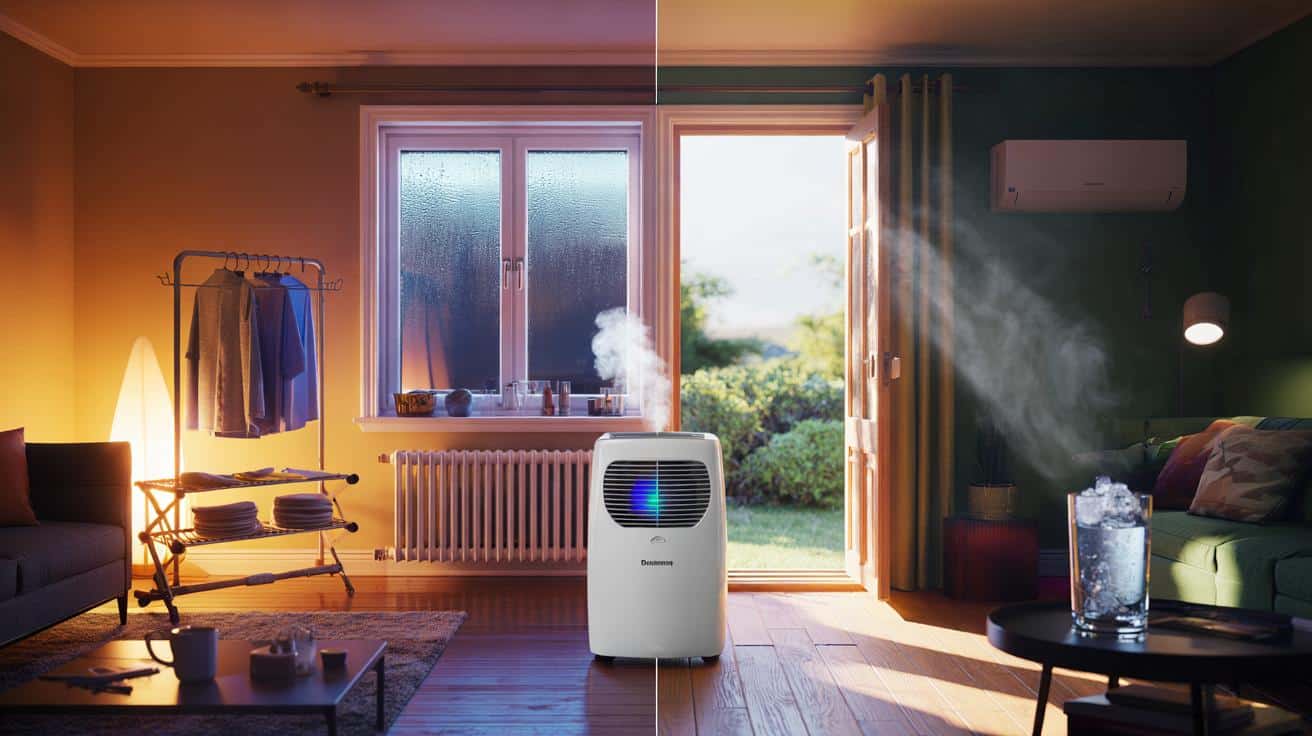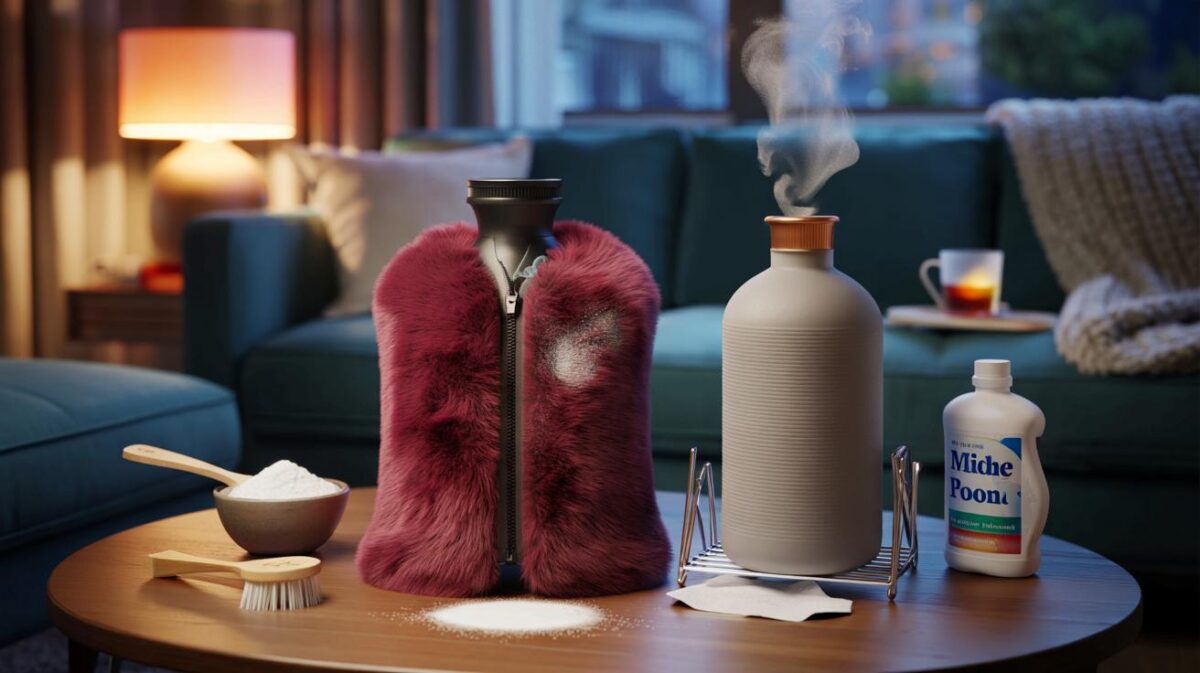So you plug in a dehumidifier and hope the numbers soften. Sometimes they do. Sometimes they don’t. The difference comes down to when, where and why you run it — not the brand on the box.
The hallway hum is easy to miss until it isn’t. I watched a small white unit gulp the wet from a family’s winter, its fan steady, its tank filling with a faintly sour litre of everyday life: showers, soup, wet hoodies from a late train. The radiators ticked, the double glazing misted, and a sticky cold clung to the walls you could almost touch. Their boiler had been working hard, yet the house still felt damp. They wanted a trick. They wanted a lower bill. The machine promised both. The room felt different by evening. The bill? That’s the part that trips people up. A quiet surprise was coming.
When dehumidifiers actually save energy
There’s a physics story hiding in that plastic shell. A compressor dehumidifier pulls moist air over a cold coil, condenses the water, then throws slightly warmer, drier air back into the room. In winter that warmth isn’t wasted — it stays indoors. Each kilowatt-hour you feed it becomes heat, and the act of condensing water releases extra heat too. That’s why a good unit can feel like a small, gentle heater while it dries your socks.
Numbers make it easier to see. A typical UK compressor model draws 200–300 watts; running for eight hours might cost 40–70p at 25–30p/kWh. Many units deliver around 1.5–2.5 litres of water per kWh in a 20°C room. Condensing one litre of water releases roughly 0.68 kWh of heat, which also warms your space. Dry two litres and you’ve quietly added about 1.36 kWh of heat, on top of the electricity you already paid for. Drying laundry like this often beats a vented tumble dryer on cost. In a heated room, a dehumidifier’s “waste heat” isn’t waste at all.
There’s a catch hiding in the calendar. Warm months flip the logic, because the dehumidifier’s heat has nowhere “useful” to go. It warms a room you’re trying to cool. If an air conditioner is running nearby, the dehumidifier is adding heat the AC must remove while it removes moisture — a tug of war on your wallet. In those moments, let the AC handle humidity in “dry” mode, or slow the fan so the coil spends more time wringing water from the air. This is the quiet maths of moisture.
And when they quietly cost you more
Use a dehumidifier to fight the weather, not a window. If outside air is streaming in through a leaky sash or you’re airing rooms with doors wide open, the machine will run and run, trying to dry tomorrow’s breeze. Close the room, shut trickle vents for a session, and aim for 45–55% relative humidity in winter, a touch higher in summer. Targeted sessions — evenings after showers, laundry days, damp basements — beat a 24/7 drone.
We’ve all had that moment when the bathroom mirror fogs, the kids’ coats go on a radiator, and the house starts to smell faintly of old sponge. That’s your dehumidifier’s sweet spot. Post-shower, post-mop, post-laundry. Run it in the room where moisture is born and keep the door closed. A load of washing can hold 1–2.5 litres of water even after a good spin; capturing that indoors with a dehumidifier costs far less than reheating a soggy house. In a warm spell, the same machine turns into a tiny space heater you didn’t ask for.
There’s also the question of type. Compressor models are efficient in mild, heated spaces. Desiccant units use a different tech that drinks moisture even in colder rooms, like garages and boats, but they draw more power and run hotter. Think of them as specialists, not daily drivers. If a room sits below 10°C, a desiccant can make sense; in a lounge at 18–21°C, a compressor will sip less. A dehumidifier is not a magic fix for a damp house. Find the leak, use extract fans, and let the small box do the last 20%, not the first 80%.
How to use one the smart way
Start with a cheap hygrometer. Stick it on the wall and watch it for a week. Aim for 40–50% RH in winter and 45–60% in summer. Set the dehumidifier’s target to that range, run laundry mode when you’re drying clothes, and let the unit cycle itself off. Place it centrally in the problem room, away from curtains, and leave doors closed for two-hour bursts. Drain via hose if you can; emptying a tank is exactly the sort of thing people forget.
Clean the dust filter monthly and give the coils a gentle brush when they look fuzzy. Small clogs steal performance and bump your running time. Position laundry so air can move around it — a cheap fan on low can halve drying time when paired with the dehumidifier. And don’t chase a flood with a desk-sized unit. After a leak, hire a proper drying rig for a few days, then keep a domestic model for maintenance. Let’s be honest: nobody actually does that every day.
Think in rules of thumb, not apps and dashboards. Keep windows shut during a drying session, run extractors during cooking and showers, and tackle the sources first. Then use the machine to finish the job and keep mould at bay.
“Dehumidifiers save energy when they replace moisture at the source or replace a more expensive habit,” a building scientist told me. “They cost more when they fight your whole neighbourhood.”
- Best targets: 45–55% RH in winter; 50–60% in summer.
- Best times: after showers, cooking, and indoor laundry.
- Best places: closed rooms, central position, clear airflow.
- Best tools: hygrometer, clean filter, drain hose.
- Red flags: windows open, constant leaks, musty lofts.
A small machine, a bigger question
Dehumidifiers are honest devices. They don’t conjure heat, they move it around and keep moisture from stealing comfort. In winter, in a room you’re already heating, they can trim bills while protecting paint, plaster and lungs. In summer, in a room you’re trying to keep cool, they work against you unless they’re replacing laundry cycles or solving a precise problem. The trick is to use them like a scalpel, not a sledgehammer. Watch the little screen. Listen for the fan that turns itself off. Share the trick with the friend who’s forever wiping their windows at dawn. The truth is less about the box and more about the habits around it.
| Key points | Detail | Reader Interest |
|---|---|---|
| Winter wins | In heated rooms, electricity plus condensation heat warms the space; drying laundry can undercut tumble-dryer costs. | Save money now, feel warmer tonight. |
| Summer pitfalls | Standalone units add heat; they can make AC work harder. Use AC “dry” mode or targeted sessions only. | Avoid paying twice to stay cool. |
| Right tool, right room | Compressor for 15–22°C rooms; desiccant for colder spaces but at higher running cost. | Buy once, use well, stop chasing damp. |
FAQ :
- Do dehumidifiers actually reduce energy bills?Yes — in a heated room with real moisture to remove. The unit’s electricity becomes heat indoors, and the condensation process adds extra warmth. Use it for laundry, post-shower sessions, and damp corners.
- Should I run a dehumidifier with air conditioning?Only for short, targeted bursts. The dehumidifier’s heat makes the AC work harder. Try your AC’s “dry” mode or a lower fan speed to boost moisture removal without adding heat.
- What humidity should I aim for at home?Keep 40–50% RH in winter to avoid condensation, and 45–60% in summer for comfort. Buy a small hygrometer so you’re not guessing.
- Compressor vs desiccant: which is cheaper to run?Compressor models are usually cheaper in rooms at 15–22°C. Desiccant units work better in colder spaces but draw more power and run hotter.
- Can a dehumidifier replace heating?No. It can add gentle heat and reduce the chill of damp air, but it won’t replace a boiler or heat pump. Use it to support comfort, not as your main heater.








